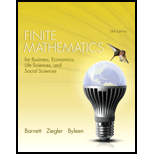
Corporate farming For a one-time play (investment), you would split your investment proportional to the entries in your optimal strategy matrix. Assume that fate is a very clever player. Then if fate deviates from its optimal strategy, you know you will not do any worse than the value of the game, and you may do better.
The managers would like to determine the best strategy against the weather's “best strategy" to destroy them. Then, no matter what the weather does, the farm will do no worse than the value of the game and may do a lot better. This information could be very useful to the company when applying for loans.
Note: For each year that the payoff matrix holds, the farm can split the planting between wheat and rice proportional to the size of entries in its optimal strategy matrix.
(A) Find the optimal strategies for the farm and the weather, and the value of the game.
(B) What is the expected value of the game for the farm if the weather (fate) chooses to play the pure strategy “wet" for many years, and the farm continues to play its optimal strategy?
(C) Answer part (B), replacing “wet" with “normal."
(D) Answer part (B), replacing “wet" with “dry.”
Want to see the full answer?
Check out a sample textbook solution
Chapter 10 Solutions
Finite Mathematics for Business, Economics, Life Sciences, and Social Sciences (13th Edition)
Additional Math Textbook Solutions
Basic Business Statistics, Student Value Edition
Elementary Statistics: Picturing the World (7th Edition)
Intro Stats, Books a la Carte Edition (5th Edition)
University Calculus: Early Transcendentals (4th Edition)
A Problem Solving Approach To Mathematics For Elementary School Teachers (13th Edition)
A First Course in Probability (10th Edition)
- 5 сл Use vectors to prove the following theorems from geometry: (a) The diagonals of a parallelogram bisect each other. (b) The median to the base of an isosceles triangle is perpendicular to the base.arrow_forwardEstimate the instantaneous rate of change of the function f(x) = 2x² - 3x − 4 at x = -2 using the average rate of change over successively smaller intervals.arrow_forwardGiven the graph of f(x) below. Determine the average rate of change of f(x) from x = 1 to x = 6. Give your answer as a simplified fraction if necessary. For example, if you found that msec = 1, you would enter 1. 3' −2] 3 -5 -6 2 3 4 5 6 7 Ꮖarrow_forward
- 5 сл Use vectors to prove the following theorems from geometry: (a) The diagonals of a parallelogram bisect each other. (b) The median to the base of an isosceles triangle is perpendicular to the base.arrow_forward78 222÷12arrow_forwardGiven the graph of f(x) below. Determine the average rate of change of f(x) from x = -2 to x = 2. Give your answer as a simplified fraction if necessary. For example, if you found that msec = , you would enter 3 2 2 3 X 23arrow_forward
- 29 Probability Theory: Central Limit Theorem Task: Refer to Question 29 in the provided document. Link: https://drive.google.com/file/d/1wKSrun-GlxirS3IZ9qoHazb9tC440AZF/view?usp=sharingarrow_forwardnot use ai pleasearrow_forwardList the possible values of a for which square root is between 6 and 7 and an element of natural numberarrow_forward
 Glencoe Algebra 1, Student Edition, 9780079039897...AlgebraISBN:9780079039897Author:CarterPublisher:McGraw Hill
Glencoe Algebra 1, Student Edition, 9780079039897...AlgebraISBN:9780079039897Author:CarterPublisher:McGraw Hill College Algebra (MindTap Course List)AlgebraISBN:9781305652231Author:R. David Gustafson, Jeff HughesPublisher:Cengage Learning
College Algebra (MindTap Course List)AlgebraISBN:9781305652231Author:R. David Gustafson, Jeff HughesPublisher:Cengage Learning Holt Mcdougal Larson Pre-algebra: Student Edition...AlgebraISBN:9780547587776Author:HOLT MCDOUGALPublisher:HOLT MCDOUGAL
Holt Mcdougal Larson Pre-algebra: Student Edition...AlgebraISBN:9780547587776Author:HOLT MCDOUGALPublisher:HOLT MCDOUGAL College AlgebraAlgebraISBN:9781305115545Author:James Stewart, Lothar Redlin, Saleem WatsonPublisher:Cengage Learning
College AlgebraAlgebraISBN:9781305115545Author:James Stewart, Lothar Redlin, Saleem WatsonPublisher:Cengage Learning



